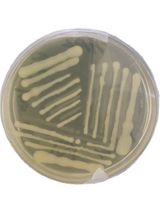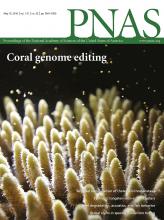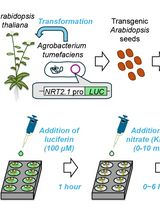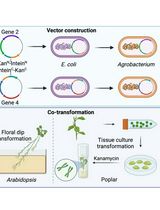- EN - English
- CN - 中文
In vitro Protein-DNA Binding Assay (AlphaScreen® Technology)
蛋白质-DNA结合的体外检测法 (AlphaScreen® Technology)
发布: 2019年02月05日第9卷第3期 DOI: 10.21769/BioProtoc.3155 浏览次数: 10151
评审: Rajeevkumar SarmaNeha AgarwalAnonymous reviewer(s)

相关实验方案

将Miniprep制备的大肠杆菌K12菌株质粒DNA转化为可用于植物遗传转化的根癌农杆菌EHA105细胞的简单可靠方法
Beenzu Siamalube [...] Steven Runo
2025年01月05日 2234 阅读
Abstract
Identification of specific DNA binding sites of transcription factors is important in understanding their functions. Recent techniques allow us to investigate genome-wide in vivo binding positions by chromatin immunoprecipitation combined with high-throughput sequencing. However, to further explore the binding motifs of transcription factors, in-depth biochemical analysis is required. Here, we describe an efficient protocol of protein-DNA interactions based on a combination of our in vitro transcription/translation system and AlphaScreen® technology. The in vitro transcription/translation system supports an efficient and quick way of protein synthesis by alleviating cumbersome cloning steps. In addition, AlphaScreen® system provides a highly sensitive, quick, and easy handling platform to investigate the protein-DNA interactions in vitro. Thus, our method largely contributes to comprehensive analysis of the biochemical properties of transcription factors.
Keywords: Transcription factor (转录因子)Background
Upon exposure to abiotic and biotic stresses, major transcriptional changes are induced in plants to help them adapt to these environmental stimuli. Transcriptional regulation is important not only for stress responses but also for plant development. In general, one transcription factor regulates an array of target genes by recognizing its corresponding cis-regulatory elements. Thus, to study the physiological role of transcription factors, identification of their specific binding sequences is a major challenge. Recently, chromatin immunoprecipitation combined with high-throughput sequencing (ChIP-seq) has enabled researchers to determine the genome-wide locations of a transcription factor-DNA interaction. However, the precise binding capability should be further confirmed by in-depth biochemical experiments.
For the past several decades, electrophoretic mobility shift assay (EMSA) and transient reporter assay using viable cells have been widely used to determine protein-DNA interactions. For EMSA, a protein-DNA complex is subjected to electrophoresis followed by the autoradiographic or immunodetection of the band shift. For transient assay, protoplasts or tissues are transformed with a plasmid that consists of a promoter sequence harboring candidate cis-regulatory elements fused with a reporter gene encoding such as luciferase or green fluorescent protein (Chalfie et al., 1994). Although these are powerful methods to investigate the direct binding site of a transcription factor and its transcriptional activity, they are time-consuming and thus cannot be applicable to a comprehensive analysis.
On the other hand, Amplified Luminescence Proximity Homogenous Assay (Alpha) technology is an emerging alternative method to effectively detect protein-DNA interaction (AlphaScreen®). AlphaScreen assay uses two types of small beads (250 nm in diameter), Acceptor and Donor beads, which are specifically designed to associate with either a target protein fused with a protein tag or a biotinylated cis-regulatory element. When the protein-DNA interaction occurs, illumination at 680 nm releases singlet oxygen from donor beads, which subsequently transfers energy to acceptor beads to generate light at 520-620 nm. Since the half-life of singlet oxygen is only 4 µsec, the interaction is not detected without close proximity (see also web site: www.perkinelmer.com/alphascreen). Since AlphaScreen® shows high sensitivity and low background in a microplate format, it can adapt to a high-throughput screening platform.
Compared to EMSA and transient assay, AlphaScreen® is considerably easier to handle and quicker for the detection of protein-DNA interaction. Moreover, we have developed a highly efficient way to synthesize proteins in vitro (Nomoto and Tada, 2018a and 2018b). This method enables us to synthesize proteins that are difficult to obtain in cell-based production systems such as E. coli. Furthermore, this method is highly time efficient because the DNA template for in vitro transcription can be made by the second round of PCR using any type of cloning vectors. To take these advantages, we describe a protocol from protein synthesis to AlphaScreen® assay for detecting protein-DNA interactions. We confirm that our method contributes to the understanding of biological roles of transcription factors function in diverse signaling pathways.
Materials and Reagents
- Aluminum foil
- 1.5 ml microcentrifuge tubes
- 0.2 ml 8 strip PCR tube and cap strips
- 5’-biotinylated and non-biotinylated 50 base single-strand DNA and complementary unmodified 50 base single-strand DNA (Eurofins, Japan)
- Plasmid containing cDNA region of the gene of interest
- Gene-specific primers for 1st and 2nd PCR (see Table 1)
- Ultrapure water (Milli-Q water)
- KOD-Plus-Neo (including 10x PCR buffer, 2 mM dNTPs, 25 mM MgSO4 and KOD-Plus-Neo DNA polymerase) (TOYOBO, catalog number: KOD-401)
- Agarose (VWR, catalog number: 0710-500g)
- Quick-Load Purple 1 kb Plus DNA ladder (0.1-10.0 kb) (New England BioLabs, catalog number N0550S)
- Ethidium bromide (Wako Pure Chemical, catalog number: 547-00101)
- RNase-free water
- 4 M ammonium acetate diluted with RNase-free water
- 99.5% ethanol (Wako Pure Chemical, special grade, catalog number: 057-00451)
- In Vitro Transcription/Translation Kit (NUProtein, catalog number: PSS3050)
- Polyacrylamide gel
- AlphaScreen FLAG® (M2) Detection kit (PerkinElmer, catalog number: 6760613C)
- AlphaPlate-384, 384-well plate (PerkinElmer, catalog number: 6005350)
- Tween® 20 (TCI, catalog number: T0543)
- Bovine serum albumin (BSA) (Sigma-Aldrich, catalog number: A2058-5G)
- Polydeoxyadenylic acid-Polythymidylic acid (dAdT) (Sigma-Aldrich, catalog number: P9764-5UN)
- DL-dithiothreitol (DTT) (Wako Pure Chemical, catalog number: 047-08973)
- Tris (hydroxymethyl) aminomethane (Wako Pure Chemical, catalog number: 207-06275)
- Glacial acetic acid (Wako Pure Chemical, catalog number: 518-33985)
- Ethylenediaminetetraacetic acid (EDTA) (DOJINDO, catalog number: 345-01865)
- Glycerol (Wako Pure Chemical, catalog number: 075-00616)
- Sodium dodecyl sulfate (SDS) (Wako Pure Chemical, catalog number: 191-07145)
- Bromophenol blue (Wako Pure Chemical, catalog number: 021-02911)
- Xylene cyanolFF (Wako Pure Chemical, catalog number: 244-00461)
- 100x TAE buffer (see Recipes)
- 10x loading dye (see Recipes)
For SDS-PAGE and Western blotting
- Nitrocellulose membrane (GE Healthcare, catalog number: 10600007)
- WhatmanTM 3 MM Chr Chromatography Paper (GE Healthcare, catalog number: 05-714-5)
- Hybridization bag
- MXJB III Film (IBI, catalog number: 6567291)
- Precision Plus ProteinTM Dual color standards (Bio-Rad Laboratories, catalog number: 1610374)
- SDS polyacrylamide gel
- Methanol (Wako pure chemical, special grade, catalog number: 131-01826)
- Anti-DYKDDDDK tag antibody (diluted 1:2,000 in blocking buffer) (Wako Pure Chemical, catalog number: 014-22383)
- Goat anti-mouse IgG-HRP (diluted 1:1,000 in blocking buffer) (Cosmo Bio, catalog number: 1030-05)
- SuperSignalTM West Pico PLUS Chemiluminescent Substrate (Thermo Fisher Scientific, catalog number: 34577)
- Tris (hydroxymethyl) aminomethane (Wako Pure Chemical, catalog number: 207-06275)
- SDS (Wako Pure Chemical, catalog number: 191-07145)
- Bromophenol blue (Wako Pure Chemical, catalog number: 021-02911)
- Xylene cyano lFF (Wako Pure Chemical, catalog number: 244-00461)
- NaCl (Wako Pure Chemical, catalog number: 191-01665)
- Na2HPO4 (Wako Pure Chemical, catalog number: 197-02865)
- KCl (Wako Pure Chemical, catalog number: 163-03545)
- KH2PO4 (Wako Pure Chemical, catalog number: 169-04245)
- Skimmed milk powder (Wako Pure Chemical, catalog number: 190-12865)
- 10x running buffer (see Recipes)
- 4x SDS sample buffer (see Recipes)
- Transfer buffer (see Recipes)
- 10x PBS (see Recipes)
- Blocking buffer (see Recipes)
Equipment
- Pipettes
- PCR thermal cycler (Thermo Fisher Scientific, model: Veriti 200)
- Refrigerated centrifuge (Hitachi, model: himac CF 15R)
- Vortex mixer
- Block incubator (You can use a water incubator instead of block incubator.)
- Wonder Shaker (NISSIN, model: NA-4X)
- Multi Shaker (Tokyo Rikakikai Co., Ltd., model: MMS-120H)
- Heat Sealer (Taiyo Electric Co., Ltd., model: HS-400)
- Trans-Blot® SD Semi-Dry Electrophoretic Transfer Cell (Bio-Rad Laboratories, catalog number: 170-3940)
- Fuji Medical Film Processor (FUJIFILM Medical, model: FPM100)
- X-ray film cassette
- EnSpireTM Alpha Plate Reader (PerkinElmer, model: 2390-00000)
Note: Equipment #5 to #11 are shown for your reference for SDS-PAGE and Western blotting.
Procedure
文章信息
版权信息
© 2019 The Authors; exclusive licensee Bio-protocol LLC.
如何引用
Nomoto, M., Tada, Y. and Tsukagoshi, H. (2019). In vitro Protein-DNA Binding Assay (AlphaScreen® Technology). Bio-protocol 9(3): e3155. DOI: 10.21769/BioProtoc.3155.
分类
分子生物学 > 蛋白质 > 检测
植物科学 > 植物分子生物学 > DNA > 基因表达
分子生物学 > DNA > DNA-蛋白质相互作用
您对这篇实验方法有问题吗?
在此处发布您的问题,我们将邀请本文作者来回答。同时,我们会将您的问题发布到Bio-protocol Exchange,以便寻求社区成员的帮助。
Share
Bluesky
X
Copy link










